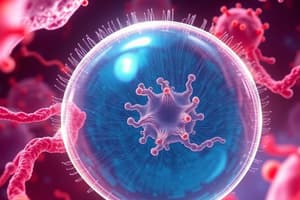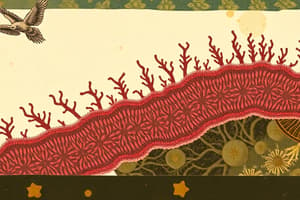Podcast
Questions and Answers
What structure is formed by the combination of centrioles and a protein matrix?
What structure is formed by the combination of centrioles and a protein matrix?
- Flagella
- Cilia
- Centrosome (correct)
- Nucleus
Which of the following structures is specifically associated with the movement of sperm cells?
Which of the following structures is specifically associated with the movement of sperm cells?
- Flagella (correct)
- Centrioles
- Cilia
- Centrosomes
Which component is a significant characteristic of plant cells but absent in animal cells?
Which component is a significant characteristic of plant cells but absent in animal cells?
- Chloroplast (correct)
- Cytoplasm
- Mitochondria
- Cell membrane
What is the main role of centrosomes during cell division?
What is the main role of centrosomes during cell division?
What is the primary reason polar molecules are soluble in water?
What is the primary reason polar molecules are soluble in water?
Which of the following accurately describes the structure of cilia?
Which of the following accurately describes the structure of cilia?
What percentage of a cell is typically made up of water?
What percentage of a cell is typically made up of water?
Which structure aids the movement of mucus in the respiratory system?
Which structure aids the movement of mucus in the respiratory system?
What is a major characteristic of nonpolar molecules in relation to water?
What is a major characteristic of nonpolar molecules in relation to water?
Which of the following ions is NOT mentioned as an inorganic ion essential for cell function?
Which of the following ions is NOT mentioned as an inorganic ion essential for cell function?
What percentage of a cell's dry weight is typically made up of macromolecules?
What percentage of a cell's dry weight is typically made up of macromolecules?
Which of the following is considered a precursor of macromolecules?
Which of the following is considered a precursor of macromolecules?
What is one of the main functions of inorganic ions in cells?
What is one of the main functions of inorganic ions in cells?
What type of organic molecules are lipids classified as?
What type of organic molecules are lipids classified as?
Which organic components are classified as macromolecules?
Which organic components are classified as macromolecules?
Why do nonpolar molecules tend to associate with each other?
Why do nonpolar molecules tend to associate with each other?
What is the primary function of rough endoplasmic reticulum (RER)?
What is the primary function of rough endoplasmic reticulum (RER)?
Which organelle is responsible for modifying and packaging proteins and lipids?
Which organelle is responsible for modifying and packaging proteins and lipids?
What role does the smooth endoplasmic reticulum (SER) primarily serve?
What role does the smooth endoplasmic reticulum (SER) primarily serve?
What is the main function of lysosomes within a cell?
What is the main function of lysosomes within a cell?
Which of the following is true regarding the structure of Golgi apparatus?
Which of the following is true regarding the structure of Golgi apparatus?
Which type of endoplasmic reticulum is most abundant in liver cells due to its function?
Which type of endoplasmic reticulum is most abundant in liver cells due to its function?
What process do lysosomes facilitate when a cell is severely worn out?
What process do lysosomes facilitate when a cell is severely worn out?
What is a key feature that differentiates smooth endoplasmic reticulum from rough endoplasmic reticulum?
What is a key feature that differentiates smooth endoplasmic reticulum from rough endoplasmic reticulum?
What are simple amides classified as?
What are simple amides classified as?
What is formed when a halide group replaces a hydroxyl group in carboxylic acids?
What is formed when a halide group replaces a hydroxyl group in carboxylic acids?
Which organization establishes the naming conventions for organic compounds?
Which organization establishes the naming conventions for organic compounds?
Which of the following best describes biochemistry?
Which of the following best describes biochemistry?
Why is biochemistry important for understanding nutrition?
Why is biochemistry important for understanding nutrition?
What role can biochemistry play in the field of pharmaceuticals?
What role can biochemistry play in the field of pharmaceuticals?
Which of the following is NOT a reason biochemistry is utilized?
Which of the following is NOT a reason biochemistry is utilized?
Which of the following fields does biochemistry encompass?
Which of the following fields does biochemistry encompass?
What distinguishes phenols from alcohols in terms of their chemical behavior?
What distinguishes phenols from alcohols in terms of their chemical behavior?
Which best describes the structure of ketones?
Which best describes the structure of ketones?
What is the functional group present in carboxylic acids?
What is the functional group present in carboxylic acids?
What are esters commonly used for?
What are esters commonly used for?
What type of compounds do ethers consist of?
What type of compounds do ethers consist of?
What is the general formula for amides?
What is the general formula for amides?
What is one defining characteristic of amines?
What is one defining characteristic of amines?
Which of the following statements about aldehydes is accurate?
Which of the following statements about aldehydes is accurate?
Flashcards are hidden until you start studying
Study Notes
Endoplasmic Reticulum
- The endoplasmic reticulum (ER) is a network of membranes that extend from the nuclear envelope to the plasma membrane
- The ER increases the surface area of the cell to accommodate various cellular functions
- There are two types of ER, rough and smooth.
- Rough endoplasmic reticulum (RER) has ribosomes attached to its surface, giving it a rough appearance
- RER is involved in the synthesis of proteins and modification of proteins that will be secreted by the cell.
- Smooth endoplasmic reticulum (SER) has fewer ribosomes attached to its surface and is involved in the synthesis of lipids, carbohydrates, detoxification of medicines and toxic substances, and storage
- SER also aids in the absorption of calcium ions within the cell, particularly in the muscle cells.
Golgi Apparatus
- The Golgi apparatus, also known as the Golgi complex or Golgi body, is a membrane-bound organelle composed of flattened sacs called cisternae
- The Golgi apparatus is involved in the transport, modification, and packaging of proteins and lipids via vesicles.
- Vesicles are small structures that are enclosed by a lipid bilayer and are transported to other cells through cell signaling
- Plant cells contain hundreds of Golgi apparatuses.
Lysosomes
- Lysosomes are membrane-bound organelles that contain digestive enzymes that break down worn-out cell parts and organelles.
- Lysosomes also destroy foreign materials like viruses and bacteria in the cell.
- Lysosomes are involved in programmed cell death called apoptosis.
- The lysosome's membrane protects the cell from the acidic contents within.
Centrioles
- Centrioles are involved in the development of cilia and flagella.
- Centrioles are found in animal and lower plant cells.
- A centrosome is a combination of centrioles surrounded by a protein matrix.
- Centrosomes appear before cell division and direct the movements of microtubules and other cytoskeletal structures and proteins during cell division.
- Centrosomes facilitate changes in the cells' shapes during cell division.
Cilia and Flagella
- Cilia and flagella are projections from the cell that aid in cell motility.
- Cilia are shorter than flagella, but both are made up of the same protein components.
- Cilia in the bronchus of the respiratory system move mucus and other materials.
- Sperm cells are the only animal cells that have flagella.
Cell Types (Eukaryotes)
- Animal, plant, fungal, and protist cells are eukaryotic cells that are unique in structure and function.
- Animal and plant cells share similar components including the nucleus, cytoplasm, mitochondria, and cell membrane.
- Plant cells have a vacuole, chloroplast, and cell wall that are absent in animal cells.
Chemical Composition of Cells
- At least 70% of cells are water.
- Water molecules can interact with positively or negatively charged ions as well as other polar molecules and form hydrogen bonds with them due to their polar nature.
- Polar molecules and ions easily dissolve in water, making them hydrophilic.
- Nonpolar molecules are poorly soluble in an aqueous environment because they cannot interact with water, making them hydrophobic.
- Nonpolar molecules usually associate with each other to reduce their contact with water.
- Interactions between polar and nonpolar molecules and water are essential for the development of biological structures like cell membranes.
- Inorganic ions such as sodium (Na+), potassium (K+), magnesium (Mg2+), calcium (Ca2+), phosphate (HPO42-), chloride (Cl-), and bicarbonate (HCO3-) make up less than 1% of the mass of the cell.
- Inorganic ions are involved in several facets of cell metabolism.
- Organic molecules such as lipids, proteins, carbohydrates, and nucleic acids make up the bulk of the cell mass.
- These molecules are often called macromolecules because they are made up of hundreds or thousands of low-molecular-weight precursors.
- 80–90% of the dry weight of most cells is made up of these macromolecules.
Why Are Cells Generally Small?
- The surface area to volume ratio of a cell affects its ability to take in nutrients and expel waste products.
- Smaller cells have a higher surface area to volume ratio than larger cells, allowing for more efficient exchange of materials.
Do All Cells Have The Same Parts?
- No, not all cells have the same parts.
- Different cells have different structures and functions.
- For example, plant cells have chloroplasts, which are not found in animal cells.
Biochemistry and its discipline
- Biochemistry is the chemistry of life.
- Biochemistry studies life at the molecular level.
- It encompasses other disciplines like cell biology, genetics, immunology, microbiology, pharmacology, and physiology.
- Biochemistry helps us understand how living organisms work, such as information transfer, digestion, absorption, cell growth, and death.
What Is Biochemistry Used For?
- Biochemistry is used to investigate the characteristics of biological substances, such as proteins, lipids, and carbohydrates
- It is used to employ biomolecules in various applications, such as in pharmaceuticals, cosmetics, and food products.
Studying That Suits You
Use AI to generate personalized quizzes and flashcards to suit your learning preferences.





